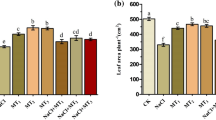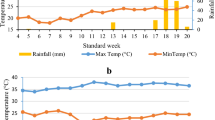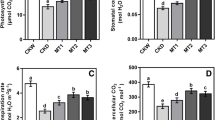Abstract
Abiotic stresses occur together in several combinations in nature and do not usually act alone. However, studies on plants mainly are limited to a single stress type. Yet, atmospheric trends make it indispensable to expand approaches to investigate physiological consequences under multiple abiotic stresses. The potential of Melatonin (Mel) hydropriming on photosynthetic machinery and antioxidant system was investigated in this study. Mel hydropriming (0.1 mmol/mL) resulted in leaf photochemistry protection, which is characterized by maximum photochemical efficiency of PSII, photosynthetic pigments intactness, reactive oxygen species (ROS) scavenging enzymes activation accompanying depressed levels of endogenous hydrogen peroxide (H2O2) and membrane oxidation in maize seedlings at early vegetative stage under combination of 150 mM NaCl and 37 ± 3 °C mild heat. Mimicking nature by combining stresses is more realistic to study abiotic stress responses. High antioxidant capacity of melatonin can serve as a hydropriming substance to withstand simultaneous heat and salt stress.




Similar content being viewed by others
References
Aebi H (1983) Catalase. In: Bergmeyer H (ed) Methods of enzymatic analysis. Weinheim-Verlag Chemie, Weinheim, pp 273–286
Arnao MB, Hernández-Ruiz J (2006) The physiological function of melatonin in plants. Plant Signal Behav 1:89–95
Ashraf M (2010) Inducing drought tolerance in plants: recent advances. Biotechnol Adv 28:169–183
Ashraf M, Harris PJC (2013) Photosynthesis under stressful environments: an overview. Photosynthetica 51:163–190
Beauchamp C, Fridovich I (1971) Superoxide dismutase: improved assays and an assay applicable to acrylamide gels. Anal Biochem 44:276–287
Bokszczanin KL, Fragkostefanakis S (2013) Perspectives on deciphering mechanisms underlying plant heat stress response and thermotolerance. Front Plant Sci 4:315
Bradford MM (1976) A rapid and sensitive method for the quantitation of microgram quantities of protein utilizing the principle of protein–dye binding. Anal Biochem 72:248–254
Dawood MG, El-Awadi ME (2015) Alleviation of salinity stress on Vicia faba L. plants via seed priming with melatonin. Acta Biol Colomb 20(2):223–235
FAO (Food and Agriculture Organization of the United Nations) (2016) Save and grow in practice maize rice wheat a guide to sustainable cereal production, Rome. http://www.fao.org/3/a i4009e.pdf. Accessed 4 Apr 2018
Foyer CH, Halliwell B (1976) Presence of glutathione and glutathione reductase in chloroplast: a proposed role in ascorbic acid metabolism. Planta 133:21–25
Heath RL, Packer L (1968) Photoperoxidation in isolated chloroplasts. I. Kinetics and stoichiometry of fatty acid peroxidation. Arch Biochem Biophys 125:189–198
Janas KM, Posmyk MM (2013) Melatonin, an underestimated natural substance with great potential for agricultural application. Acta Physiol Plant 35:3285–3292
Kataria S, Jajoo A, Guruprasad KN (2014) Impact of increasing ultraviolet-B (UV-B) radiation on photosynthetic processes. J Photochem Photobiol B 137:55–66
Kolodziejczyk I, Dzitko K, Szewcyk R, Posmyk MM (2016) Exogenous melatonin improves corn (Zea mays L.) embryo proteome in seeds subjected to chilling stress. J Plant Physiol 193:47–56
Lack B, Daya S, Nyokong T (2001) Interaction of serotonin and melatonin with sodium, potassium, calcium, lithium and aluminium. J Pineal Res 31:102–108
Li W, Zhang C, Lu Q, Wen X, Lu C (2011) The combined effect of salt stress and heat shock on proteome profiling in Suaeda salsa. J Plant Physiol 168:1743–1752
Li X, Wei JP, Scott ER et al (2018) Exogenous melatonin alleviates cold stress by promoting antioxidant defense and redox homeostasis in Camellia sinensis L. Molecules 23:165
Liang D, Gao F, Ni Z, Lin Z, Deng Q, Tang Y et al (2018) Melatonin improves heat tolerance in kiwifruit seedlings through promoting antioxidant enzymatic activity and glutathione s-transferase transcription. Molecules 6:23
Martinez V, Nieves-Cordones M, Lopez-Delacalle M et al (2018) Tolerance to stress combination in tomato plants: new insights in the protective role of melatonin. Molecules 23:535
Nar H, Saglam A, Terzi R, Várkonyi Z, Kadioglu A (2009) Leaf rolling and photosystem II efficiency in Ctenanthe setosa exposed to drought stress. Photosynthetica 47:429–436
Pandey P, Ramegowda V, Senthil-Kumar M (2015) Shared and unique responses of plants to multiple individual stresses and stress combinations: physiological and molecular mechanisms. Front Plant Sci 36:6e14
Paredes DS, Reiter RJ (2010) Melatonin: Helping cells cope with oxidative disaster. Cell Membr Free Radic Res 2:99–108
Porra RJ, Thompson WA, Kriendemann PE (1989) Determination of accurate extinction coefficients and simultaneous equations for assaying chlorophyll a and b extracted with four different solvents: verification of the concentration of chlorophyll standards by atomic absorption spectroscopy. Biochim Biophys Acta 975:384–394
Reiter RJ, Tan DX, Galano A (2014) Melatonin reduces lipid peroxidation and membrane viscosity. Front Physiol 5:1–4
Rivero RM, Mestre TC, Mittler R, Rubio F, Garcia-Sanchez F, Martinez V (2014) The combined effect of salinity and heat reveals a specific physiological, biochemical and molecular response in tomato plants. Plant Cell Environ 37:1059–1073
Rukavtsova EB, Lebedeva AA, Zakharchenko NS, Buryanov YI (2013) The ways to produce biologically safe marker-free transgenic plants. Russ J Plant Physiol 60:14–26
Saraswat S, Yadav AK, Sirohi P, Singh NK (2017) Role of epigenetics in crop improvement: water and heat stress. J Plant Biol 60:231–240
Shi H, Jiang C, Ye T, Tan DX et al (2015) Comparative physiological, metabolomic, and transcriptomic analyses reveal mechanisms of improved abiotic stress resistance in bermudagrass [Cynodon dactylon (L). Pers.] by exogenous melatonin. J Exp Bot 66:681–694
Urbanek H, Kuzniak-Gebarowska E, Herka K (1991) Elicitation of defense responses in bean leaves by Botrytis cinerea polygalacturonase. Acta Physiol Plant 13:43–50
Velikova V, Yordanov I, Edreva A (2000) Oxidative stress and some antioxidant systems in acid rain-treated bean plants. Protective role of exogenous polyamines. Plant Sci 151:59–66
Wang P, Sun X, Li C, Wei Z, Liang D, Ma F (2013a) Long-term exogenous application of melatonin delays drought-induced leaf senescence in apple. J Pineal Res 54:292–302
Zhang J, Li H, Xu B, Li J, Huang B (2016) Exogenous melatonin suppresses dark-induced leaf senescence by activating the superoxide dismutase-catalase antioxidant pathway and down-regulating chlorophyll degradation in excised leaves of perennial ryegrass (Lolium perenne L.). Front Plant Sci 7:1500
Zhang YP, Yang SJ, Chen YY (2017) Effects of melatonin on photosynthetic performance and antioxidants in melon during cold and recovery. Biol Plant 61:571–578
Zheng XD, Tan DX, Allan AC, Zuo BX, Zhao Y, Reiter RJ, Wang L, Wang Z, Guo Y, Zhou JZ, Shan DQ, Li QT, Han ZH, Kong J (2017) Chloroplastic biosynthesis of melatonin and its involvement in protection of plants from salt stress. Sci Rep 7:41236
Acknowledgements
This work was conducted with the grant provided by the Research Fund of Recep Tayyip Erdogan University (Project ID: 645).
Author information
Authors and Affiliations
Corresponding authors
Additional information
Communicated by S. Esposito.
Rights and permissions
About this article
Cite this article
Pehlivan, N., Guler, N.S. Protective effect of a natural ally on simultaneous mild heat and salt episodes in maize seedlings. Acta Physiol Plant 40, 203 (2018). https://doi.org/10.1007/s11738-018-2781-x
Received:
Revised:
Accepted:
Published:
DOI: https://doi.org/10.1007/s11738-018-2781-x




